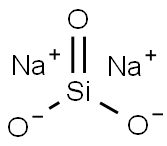Sodium Silicate(Water Class) CAS# 1344-09-8
Water glass is an aqueous solution of silicate, which is as crystal clear as glass but as fluid as water. It is a soluble alkali metal silicate material composed of a combination of alkali metal oxides and silica.
Water glass plays an important role in industry, agriculture, technology and other fields. As a binder, water glass has occupied a place in the industrial field since its inception. It can be used to block the sewage leaked from the Fukushima nuclear power plant, or to repair cracks in brick walls; it also has anti-corrosion and acid resistance properties. , is an important material for acid-resistant floors and acid-resistant pools in industrial buildings; painting concrete pavements with water glass can also increase the frost resistance and water resistance of the pavement.
发送询盘
Sodium Silicate(Water Class) CAS# 1344-09-8
| Sodium silicate Basic information |
| Product Name: | Sodium silicate |
| Synonyms: | l96(salt);metso99;n38;n38(silicate);portila;pyramid1;pyramid8;q70 |
| CAS: | 1344-09-8 |
| MF: | Na2O3Si |
| MW: | 122.06 |
| EINECS: | 215-687-4 |
| Product Categories: | UVCBs-inorganic;AAS;AAS CRMsAlphabetic;AASSpectroscopy;Application CRMs;S;SA – SM;Spectroscopy;AA Standard SolutionsAlphabetic;Reference/Calibration Standards;Standard Solutions;Chemical Synthesis;Inorganic Salts;Materials Science;Metal and Ceramic Science;Salts;Sodium;Sodium Salts;Synthetic Reagents |
| Mol File: | 1344-09-8.mol |
 |
|
| Sodium silicate Chemical Properties |
| Melting point | 1410???C(lit.) |
| Boiling point | 2355???C(lit.) |
| density | 2.33?g/mL?at 25???C(lit.) |
| storage temp. | -20??C |
| solubility | H2O: soluble |
| form | powder |
| color | Colorless |
| Water Solubility | very slightly soluble cold H2O [MER06] |
| Merck | 13,8751 |
| Dielectric constant | 16.0??Ambient?? |
| Stability: | Stable. Incompatible with acids, most metals, many organic materials. |
| InChIKey | NTHWMYGWWRZVTN-UHFFFAOYSA-N |
| CAS DataBase Reference | 1344-09-8(CAS DataBase Reference) |
| EPA Substance Registry System | Sodium silicate (1344-09-8) |
- 2
- 2-diallylpent-4-en-1-amine
- 4
- 95-16-9
- Ammonium sulfamate
- Benzothiazole
- cas:67889-00-3ح2
- cas:83524-75-8 | pigment black 32
- cas:928836-00-4 | 2
- cas:932745-70-5 | 4
- Chemical Minerals
- Coconut diethanolamide
- Daily Chemicals
- discount
- for sale
- General pvc resin
- hexyl D-glucoside
- in stock
- Lauramidopropyl betaine
- LAURIC ACID MONOETHANOLAMIDE
- Petroleum Additives
- Plasticiser
- Ploymers
- price
- PVC
- quotation
- Raw Materal
- Remove term: Petroleum Additives Petroleum Additive
- SODIUM ETHYL 2-SULFOLAURATE
Related Products
Copper(II) sulfate, with the chemical formula CuSO4, is a blue crystalline compound that is soluble in water. It is commonly used in agriculture as a fungicide and in the textile industry as a dye fixative. Copper(II) sulfate is also utilized in the manufacture of pigments, batteries, and as an algaecide in water treatment. Its distinctive blue color and reactivity make it a versatile chemical in various industrial applications, including chemical analysis and electroplating.
Chemical Name: Ashwagandha Extract
Synonyms: Withania somnifera, ext.; Withania Somnefera Extract
CAS: 90147-43-6
Appearance: Brown
Product name:Cyclopentane
Purity:96%
Appearance:White powder
Package:25kg/bag
Sample:Available
Chemical Name: o-Xylene
Synonyms: 1,2-Dimethylbenzene; ortho-xylene
CAS No.: 95-47-6
Molecular Formula: C8H10
Molecular Weight: 106.17
Chemical Name: Dehydrocholic acid
Synonyms: Acide dehydrocholique; Triketocholanic acid
CAS No.: 81-23-2
Molecular Formula: C24H34O5
Molecular Weight: 402.53
Appearance: Powder
Chromium oxide is a basic inorganic chemical raw material. Its chemical name is chromium trioxide, Cr2O3. It belongs to the trigonal crystal system. If a hexagonal unit cell is taken, the unit cell parameters are 4.960x 4.960??13.584 and the axial ratio is 4.473. Cr2O3 has a ??-Al2O3 structure. This rigid crystal is composed of oxygen ions that are closely packed and M3+ ions fill the octahedral gaps formed by these close packings.It is known that the ionic radii of Cr3+ and O2- are 0.069nm and 0.132nm respectively, and the ratio of positive and negative ionic radii is 0.52, in the range of 0.414~0.732. Therefore, the coordination number of Cr3+ is 6, so it is in the octahedral gap.
Chemical Name: Arabic gum
CAS No.: 9000-01-5
Appearance: powder
Chemical Name: Potassium Castorate
CAS No.: 8013-05-6
Molecular Formula: C57H107K3O12
Molecular Weight: 1101.74718
Appearance: Yellow Liquid
Calcium carbonate, with the chemical formula CaCO3, is an inorganic compound found in nature as calcite, aragonite, and vaterite. It is a white solid that is insoluble in water but soluble in acid. Widely used as a filler and coating pigment in paper and plastics, calcium carbonate also serves as a primary ingredient in the production of cement and lime. Known for its high purity and chemical stability, it is utilized in pharmaceuticals, food additives, and as a dietary calcium supplement. Its versatility makes it an essential component in various industrial applications.
Ammonium sulfamate is a white crystalline compound with the chemical formula (NH4)2SO3. It is a versatile chemical used in various applications, including as a flame retardant, a fertilizer ingredient, and a chemical intermediate. In the agricultural sector, it serves as a source of nitrogen, promoting plant growth. As a flame retardant, it is effective in reducing the flammability of materials. Additionally, it is used in the synthesis of other chemicals due to its reactivity with amines and other organic compounds. Its properties make it a valuable component in a range of industrial processes.
Chemical Name: Zinc citrate
Synonyms: Zinc citrate trihydrate
CAS No.: 546-46-3
Molecular Formula: C6H8O7Zn
Molecular Weight: 257.5
Appearance: White powder
Ammonium sulfamate is a white crystalline compound with the chemical formula (NH4)2SO3. It is a versatile chemical used in various applications, including as a flame retardant, a fertilizer ingredient, and a chemical intermediate. In the agricultural sector, it serves as a source of nitrogen, promoting plant growth. As a flame retardant, it is effective in reducing the flammability of materials. Additionally, it is used in the synthesis of other chemicals due to its reactivity with amines and other organic compounds. Its properties make it a valuable component in a range of industrial processes.

















